The Essential Role of Bees in Flower Pollination
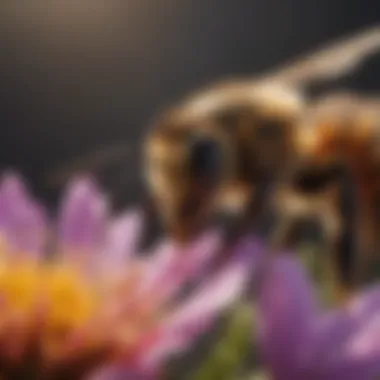
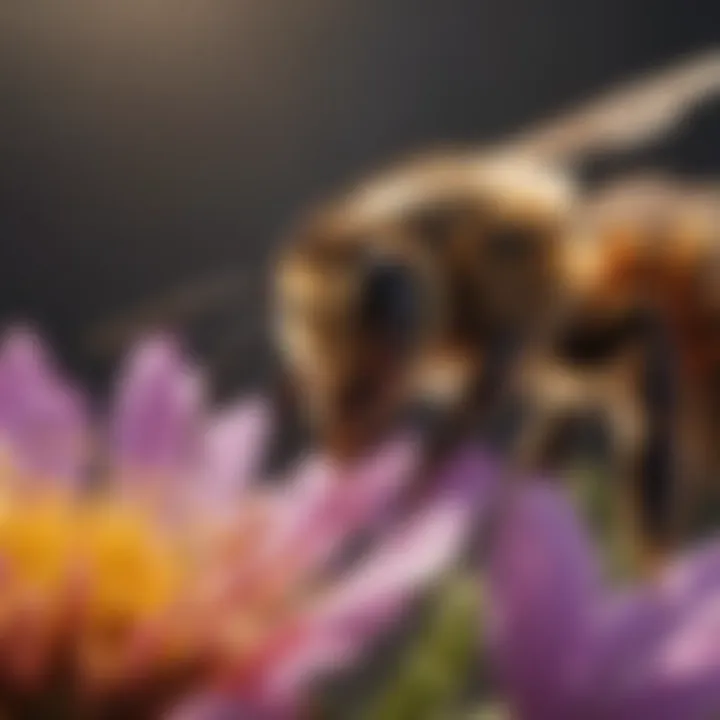
Intro
Pollination is a term that evokes many vivid images, from the sight of bumbles buzzing between daisies to the gentle flutter of honeybees in a field. But at its core, this process is much more than a mere dance between insects and blossoms. It's a critical component of our ecosystem that ensures the survival of countless plant species and, ultimately, the food chain upon which humans and other animals rely. Bees, particularly honeybees and various native species, play a monumental role in this interaction, acting as nature’s key players in ensuring plants reproduce and thrive.
Understanding the role of bees in flower pollination is vital not just for agronomists and farmers but for anyone invested in the health of our natural world. This knowledge highlights the intricate connections that bind flora and fauna together, painting a portrait of dependability that is both beautiful and crucial. As we delve into this in-depth exploration of pollination, we will navigate through various aspects of the subject, unraveling the complex behaviors of bees and their symbiotic relationships with flowers.
Overview of the Topic
In this section, we aim to define pollination and explore its importance in agricultural ecosystems and biodiversity.
Definition and Importance
Pollination is the transfer of pollen from the male anthers of a flower to the female stigma. This seemingly simple biological function facilitates the process of fertilization, allowing plants to produce seeds and propagate. Without pollination, many plants would be unable to reproduce, leading to a decline in plant diversity and affecting the species that depend on these plants for food.
Bees, due to their frequent and efficient foraging behavior, are particularly effective at this task. According to studies, nearly 75% of flowering plants depend on animal pollinators, and indisputably, bees are among the most important of these pollinators. The economic contribution of bee pollination to agriculture is staggering, with billions of dollars attributed to the crops that are dependent on these industrious insects.
Current Trends
In recent years, there has been a growing recognition of the decline in bee populations, primarily due to habitat loss, pesticides, and climate change. This trend poses a significant threat to not only biodiversity but also agricultural productivity. As such, there’s been a surge in interest around practices that support bee health and promote sustainable farming techniques.
Farmers and agricultural enthusiasts alike have started exploring ways to harness the power of bees while ensuring their survival. Initiatives have emerged, such as establishing wildflower strips along crop fields and promoting organic practices, to better the habitat for these critical pollinators. It's a pivotal time for anyone in the agricultural sector to reflect on their practices and consider how they might contribute to the well-being of bee populations.
Key Techniques and Practices
Understanding the role of bees in pollination is just a start. We can take it further by implementing specific techniques that can bolster their presence and effectiveness in our agricultural landscapes.
Step-by-Step Guide
- Planting Diverse Flora: Diversity in plant species not only provides food for bees but also ensures a continuous bloom throughout the growing season.
- Creating Bee Habitats: Set aside untouched plots where wildflowers can grow. Minimize the use of pesticides in these areas.
- Utilizing Cover Crops: Planting cover crops during off-seasons provides bees with forage when other food sources are scarce.
- Educating Others: Share knowledge about the importance of bees and engage fellow farmers to adopt bee-friendly practices.
Tools and Equipment Needed
- Native Wildflower Seeds: Ensure the selection of local species.
- Bee Hotels: These structures support solitary bee nesting.
- Organic Pesticides: Use to minimize harm to pollinators during crop management.
Challenges and Solutions
While the benefits of supporting bees are clear, farmers encounter some obstacles in their efforts towards this goal.
Common Obstacles
- Pesticide Use: Many traditional pest control measures negatively affect bee populations.
- Limited Knowledge: A lack of understanding of bee behavior and needs can hinder effective implementation.
Innovative Solutions
- Integrated Pest Management (IPM): Utilizing natural pest deterrents and minimizing chemical use.
- Community Engagement: Joining local coalitions to share resources and strategies can enhance overall community practices.
"Bees are not just part of agriculture; they are the lifeblood of a healthy planet. Their protection is paramount for both ecosystems and economies alike."
As we move forward in the exploration of this critical topic, we gather insights about the behaviors and anatomy of bees, alongside the mechanics of pollination that underline their interactions with various floral species.
Stay tuned as we navigate through the next layers of this vibrant topic, shedding light on the symbiotic connections between bees and flowers.
Prelims to Pollination
Pollination is not just a mere act of transferring pollen from one flower to another; it is the lifeblood of many ecosystems, playing a pivotal role in sustaining biodiversity. In the context of this article, examining the nuances of pollination reveals how intertwined plant and animal lives are, particularly through the lens of bees. By understanding pollination, we gain insight into the delicate balance that underpins our agricultural systems and natural environments.
The Concept of Pollination
At its core, pollination is the process that allows plants to reproduce. It involves the transfer of pollen grains from the male part (anther) of a flower to the female part (stigma) of another flower. While the mechanics might sound straightforward, the various methods of how this occurs show the complexity of nature at work. Bees, butterflies, and wind all play a role, but it is the bees that stand out for their efficiency and effectiveness. A flower’s ability to attract these busy insects with its nectar and pollen has led to a symbiotic relationship that benefits both parties. This interdependence highlights the intricate connections within ecosystems, emphasizing that every flower has a purpose beyond its radiant colors.
The Importance of Pollinators
Pollinators, particularly bees, are essential for more than just the survival of specific plants. They are critical to agricultural productivity and the economy. Nearly one-third of the food we consume relies on pollination. Fruits, nuts, vegetables - these are not merely ingredients but nutritional building blocks of our diets, directly linked to the presence of these industrious insects.
- Economic Value: The economic ramifications of bee pollination are astounding. The pollination services provided by bees are estimated to be worth billions each year. These insects support crop yields, ensuring that farmers can produce enough food to supply local and global markets.
- Biodiversity Maintenance: Pollinators keep ecosystems thriving. By promoting genetic diversity in plants, they facilitate a healthy ecosystem that can weather pests, diseases, and climate variations. It’s this variety that ensures resilience amid environmental changes.
- Food Security: As the global population increases, the demand for diverse food sources rises. Delivering ample pollination through bees can help avert food shortages, providing a steady supply of key crops.
Some may not realize the depth of their importance until considering the potential fallout of dwindling bee populations. Without them, the loss of many plant species and subsequent food sources could create a domino effect, threatening not just biodiversity but human survival itself. The stakes are high, and so understanding pollination through the lens of bee activity becomes not just an academic exercise, but a vital piece of knowledge—a call to action to protect our pollinators.
"The fine balance of nature that sustains human life teeters precariously; the role of pollinators is fundamental in maintaining this equilibrium."
As we delve deeper into the intricate relationship between bees and flowers, we will uncover the anatomy and behavior of these indispensable insects, further elucidating the commitments required to preserve their habitats and, by extension, our future.
Bee Anatomy and Behavior
Understanding the anatomy and behavior of bees is crucial to grasping their significance in flower pollination. Every aspect of their physical structure and actions is adapted for the task of pollination, ensuring that they can efficiently collect nectar and pollen while interacting with a wide array of flowering plants. This knowledge not only reveals the incredible symbiosis between bees and flowers, but it also underscores the importance of conserving bee populations as they are integral to many agricultural systems.
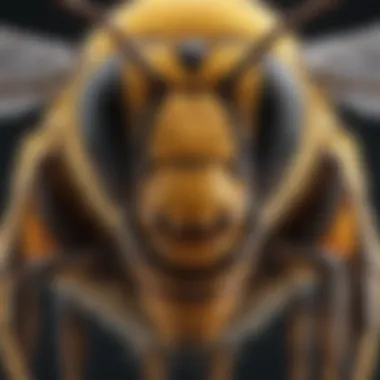
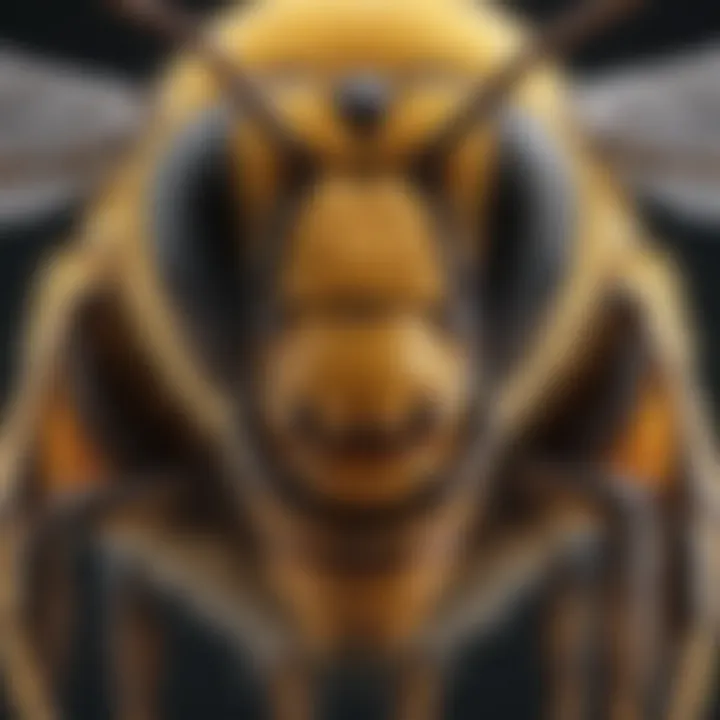
Anatomical Features of Bees
Mouthparts and Nectar Extraction
Bee mouthparts are a marvel of nature, designed specifically for the efficient extraction of nectar from flowers. The proboscis, a long, tubular structure, allows bees to reach deep into blossoms to access sweet nectar. This feature is especially beneficial for specialists, like the hummingbird moth, which may visit only specific types of flowers. By having such a tailored structure, bees can gather nectar from a variety of plants, which enhances biodiversity and supports various ecosystems.
A key characteristic of bee mouthparts is their adaptability; different bee species possess varying lengths of proboscis, depending on their feeding preferences. This can lead to competitive advantages in environments where certain flowers dominate, allowing specific bee species to thrive. However, if a bee finds itself in a habitat devoid of its preferred flower types, its ability to extract nectar effectively is diminished, showing a disadvantage of this specialization.
Legs and Pollen Transport
Bees’ legs are just as impressive as their mouthparts. The legs are equipped with structures known as pollen baskets—these are specially shaped hairs that allow bees to collect and transport pollen back to their hives. During their visits to flowers, bees inadvertently gather pollen on their legs, which they efficiently remove and deposit on other flowers, thus facilitating pollination.
A notable characteristic of bee legs is their design; the legs are not only meant for transport but also are built to ensure little loss of pollen during flight. This unique feature makes them highly effective pollinators, contributing to plant reproduction at large. On the flip side, certain environmental conditions such as rain or wind can dislodge pollen and affect transport efficiency, representing a challenge in the pollination process.
Social Structure of Bee Colonies
Roles within the Colony
In any beehive, the social structure is remarkably complex, and each bee has its own role. Worker bees, drones, and the queen each play unique parts that keep the colony functioning optimally. Workers, for instance, are responsible for foraging, nursing the brood, cleaning the hive, and defending against threats. This division of labor ensures that the colony is resilient and productive.
The key advantage of such specialization within the colony is its efficiency. When each bee focuses on a specific role, the overall productivity of the hive increases. However, reliance on social structure can be a double-edged sword; if a significant portion of the workers are lost, the hive might struggle to maintain its functions, potentially jeopardizing pollination activities in the surrounding environment.
Communication Methods
Bees have developed sophisticated methods of communication, which are essential for coordinating tasks and foraging efforts. The most well-known communication method is the waggle dance, where a worker bee performs a series of movements to relay information about the direction and distance of flowering plants from the hive.
The ability to share information about resources through such a dance is groundbreaking for the efficiency of bee foraging. It allows bees to capitalize on rich nectar sources while saving time and energy. The downside, however, is that if the environment changes—due to factors like climate shifts—bees may find it challenging to adapt their communication regarding new, emerging food sources. This limitation can hinder both their survival and the plants that rely on them for pollination.
"By exploring the behaviors and anatomy of bees, one can uncover intricate mechanisms that sustain ecosystems and agriculture alike. Their physical adaptations and social behaviors enrich the vitality of our natural world, making them invaluable players in plant reproduction."
In summary, the anatomy and behavior of bees are interlinked components that establish their efficacy as pollinators. A detailed understanding can help agricultural enthusiasts appreciate the vital contributions of bees, paving the way for better conservation practices.
Types of Bees Involved in Pollination
Understanding the types of bees that play vital roles in flower pollination is essential for appreciating their contributions to agricultural systems and ecosystems. Each bee species has unique behaviors and preferences that influence their pollination efficacy. In this section, we'll discuss three primary categories of bees that are significant in the pollination process: honey bees, bumble bees, and solitary bees. Their distinct characteristics and roles highlight the importance of diversity among pollinators, as well as the challenges they face in the modern landscape.
Honey Bees
Honey bees (Apis mellifera) stand out as the most recognized pollinators in agriculture. Their social structure enables them to work efficiently, foraging in groups and communicating through intricate dances to convey information about optimal foraging locations. This collective effort not only enhances their foraging efficiency but also promotes cross-pollination, vital for various crops.
Honey bees are particularly drawn to brightly colored flowers, especially those that are blue or purple. The nectar of these flowers provides the necessary energy for their demanding activities, while the pollen serves as a protein source for maintaining the hive's growth and health. Their importance is reflected in their economic contributions; honey bees are responsible for pollinating a significant percentage of fruits, nuts, and vegetables, contributing billions to agricultural output each year.
Bumble Bees
Bumble bees (Bombus spp.) are another crucial group of pollinators. Unlike honey bees, bumble bees are social, yet they tend to have smaller colonies. Their physiological adaptations allow them to operate effectively in cooler temperatures than many other bees. This trait is particularly beneficial for pollinating early-blooming flowers.
Bumble bees are known for their ability to perform what's called buzz pollination. This technique involves vibrating their bodies against flowers, which helps release pollen that clings to the flower's anthers. Flowers like tomatoes and peppers benefit greatly from this unique pollination method. The nimbleness of bumble bees allows them to access tubular flowers that others may find challenging, making them critical for enhancing plant diversity in both wild and cultivated settings.
Solitary Bees
Solitary bees encompass a diverse group that includes leafcutter bees and mason bees. As their name suggests, these bees do not form social colonies; instead, each female typically creates her own nest and rears her young alone. This type of bee often exhibits specialized behavior when it comes to pollination.
Many solitary bees have specific flower preferences, which means they can be highly efficient at pollinating certain plant species. For instance, mason bees are known for their role in pollinating fruit trees like apples and cherries, while leafcutter bees prefer legumes. The unique nesting habits of solitary bees, utilizing natural materials like mud or plant fibers, also make them integral to the ecosystem, as their activities contribute to soil health and stability.
In summary, understanding the diverse roles played by these types of bees is crucial for effective conservation efforts. Supporting the habitats of honey bees, bumble bees, and solitary bees will foster a resilient ecosystem and sustain agricultural productivity, ensuring that these pollinators can continue their indispensable work.
Flower Characteristics That Attract Bees
The interaction between flowers and bees represents a critical aspect of plant reproduction and ecological balance. Flowers have evolved specific characteristics that can draw bees in, facilitating a symbiotic relationship that benefits both parties. Understanding these features is essential for farmers and enthusiasts who are keen on enhancing pollination processes in agricultural settings.
Color and Shape of Flowers
One of the first things bees notice about flowers is their color. Different species of bees have varying sensitivities to colors. While humans see a vibrant spectrum, many bees are particularly drawn to shades of blue, purple, and yellow. It's like they have a radar for their favorite hues, guiding them to flowers that contain nectar and pollen.
Shapes of flowers also play a pivotal role. Bees are generally attracted to tubular or funnel-shaped blooms, which facilitate easier access to nectar. Flowers with platforms or landing sights can also help bees land without much fuss, making their job at nectar gathering smoother. A flower’s structure is like a map to the bees, showing them where to go and what to do.
"Flowers that are bright and accessible act as beacons for bees, signaling food nearby."
Fragrance and Nectar Production
The allure of a flower isn't just visual. Many flowers produce an aroma that can attract bees from great distances. Bees possess a keen sense of smell, and fragrances filled with nectar guide them toward these floral gems. When a bee catches wind of a sweet scent, it’s akin to catching a whiff of fresh baked goods wafting through the air—it simply can’t resist.
Nectar production is another crucial factor. Flowers that can offer a bountiful amount of nectar have a better chance of being visited by bees. The sweetness of nectar is essentially a reward for bees, and in return, they ensure the pollination process continues. For farmers, selecting crops that not only produce nectar but also emit pleasant fragrances can substantially increase the likeliness of bee visitation.
Temporal Variations in Flowering
Not all flowers bloom at the same time, and this temporal variation can significantly affect bee populations. Some flowers are early bloomers, while others show up later in the season. By planting a variety of flowers that flower at different times, farmers can create a continuous food source for bees throughout the growing season. This ensures that bees have access to nectar and pollen when they need it most.
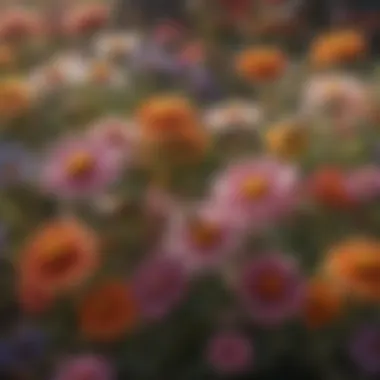

Bees, much like us, have their preferences, and these preferences can change with seasons or availability of resources. A diverse range of flowering plants helps maintain a stable bee population, encouraging resilience against environmental fluctuations.
The Mechanics of Pollination
Understanding the mechanics of pollination stands as a cornerstone in comprehending the intricate web of life that bees maintain. Pollination isn’t merely a process; it’s a symbiotic dance between flora and fauna, where bees play a leading role. This section delves into how this process occurs and the pivotal role pollen has in ensuring the vitality of both plants and the ecosystems they inhabit.
Pollination Process Explained
The process of pollination involves the transfer of pollen grains from the male anthers of a flower to the female stigma. This transfer can happen in several ways—wind, water, and importantly, animals, particularly bees. Let's break it down:
- Attraction to Flowers: Bees are visually drawn to flowers, often preferring those that are yellow or blue. The brightness of these colors combined with a pleasant scent invites them in. When bees land on a flower, they unintentionally brush against the anthers, collecting pollen on their bodies.
- Foraging: As bees collect nectar—a sugary fluid— they’re simultaneously gathering pollen. They have specialized mouthparts, perfect for this task. During this foraging, bees move from one flower to another, redistributing pollen along the way. Each visit can mean crossing strands of genetic material, making this a critical activity for biodiversity.
- Pollen Transfer: When a bee moves on to a new flower, some of the pollen stuck to its body is deposited on the stigma. This transfer is crucial for fertilization to take place. It’s a bit like a relay race; the bee delivers the pollen, ensuring the plants can reproduce.
- Fertilization: Once on the stigma, pollen grains germinate, sending pollen tubes down through the style to reach the ovules in the ovary. This action leads to fertilization, resulting in the eventual formation of seeds.
"Without pollinators like bees, many types of flowers would struggle to reproduce, ultimately leading to declines in plant populations."
Understanding this process is vital for those involved in agriculture as it not only affects crop quantity but also quality, ensuring that future generations reap the benefits of diverse and abundant food sources.
Role of Pollen in Plant Reproduction
Pollen is much more than a mere dust-like material; it is the lifeblood of plant reproduction. Here are a few key points underscoring its significance:
- Genetic Diversity: Pollen facilitates genetic variation, allowing plants to adapt to changing environments. This diversity broadens the gene pool, making populations more resilient against diseases and pests.
- 4-6% Yield Increase: Research has shown that better pollination leads to around a 4-6% increase in yield for crops like apples and almonds. This boost is a direct result of having more flowers successfully fertilized, hence producing more fruits.
- Food Production: Many commercially important crops, such as blueberries, can’t self-pollinate. They depend heavily on bees to ensure that the flowers are adequately pollinated, which directly impacts food production on a large scale.
- Cultural and Economic Value: Beyond their biological functions, flowering plants play significant roles in culture and economy, ranging from ornamental gardens to widely enjoyed food items. Thus, understanding pollen’s role helps reinforce the importance of protecting bee habitats.
Impact of Bees on Agricultural Productivity
Bees play an essential role in agricultural productivity, acting as nature's helpers when it comes to pollination. Their ability to transfer pollen from one flower to another makes them pivotal for the reproductive success of many plants, which directly correlates to the yield and quality of crops. The connection between bees and agriculture is one that has been forged over millions of years, nurturing ecosystems that are crucial for food production and biodiversity.
Pollination by bees significantly boosts crop yields. It is estimated that around 75% of the world's food crops depend, at least in part, on pollinators, primarily bees. This rather striking figure illustrates how intimately tied agriculture is to the health and survival of bee populations. An increase in bee activity often results in a noticeable uptick in the production of fruits, vegetables, nuts, and seeds.
Here's why the topic of bees and their impact on agricultural productivity is so significant:
- Economic Infrastructure: The economic benefits derived from bee-pollinated crops are substantial. In tangible terms, it translates to billions of dollars in agricultural revenue.
- Biodiversity Throwback: The presence of bees enhances plant diversity, which in turn supports a balanced ecosystem vital for sustained agricultural productivity.
- Nutritional Quality: Bees contribute not just to the quantity of crops but also to their nutritional quality. Diverse pollination yields fruits and vegetables that are richer in vitamins and minerals.
With these considerations, it becomes evident that any decline in bee populations poses a serious threat to agriculture, making conservation pertinent to both environmental health and human sustenance.
Economic Importance of Pollination
Pollination is intricately linked to our economy, especially within the agricultural sector. In the U.S. alone, bees contribute approximately $15 billion worth of crops annually through their pollination activities. This encompasses a wide range of products including fruits, vegetables, and nuts. The ripple effect is significant: higher crop yields lead to more jobs in farming, processing, and distribution. As farmers see improvements in both the quantity and quality of their produce, it leads to direct economic growth in rural areas.
Bees are not just important for humans; they create a ladder of ecological connections that benefit many life forms. The loss of these pollinators would hinder job creation in agriculture and related fields, potentially leading to economic decline in communities that depend on farming.
Crops Dependent on Bee Pollination
Fruits and Vegetables
Fruits and vegetables represent a core aspect of human diet and agriculture, relying heavily on bee pollination. Crops like almonds, blueberries, and cucumbers thrive thanks to the work bees perform. The key characteristic of these plants is their flowering periods, which often overlap with when bees are most active. This synchronized blooming allows for a productive exchange between these crops and the bee population, ensuring that pollination occurs at peak times.
One unique feature of fruits and vegetables reliant on bees is their enhanced flavor and quality resulting from better pollination. For example, strawberries and cherries develop into more succulent and larger fruits when bee pollination is optimal. However, with the decline in bee populations, farmers face challenges such as smaller harvests and a decrease in the quality of their yields.
Nuts and Seeds
Nuts and seeds also hinge significantly on bee activity, with crops like almonds, walnuts, and various seeds being prime examples. The key characteristic of these crops is their dependency on cross-pollination, which is predominantly facilitated by bees. For instance, almonds require bees to pollinate the flowers for fruit to develop, without which, the supply chain for nut products would be severely impacted.
Nuts and seeds contribute not only to food products but also to various industrial uses, making their pollination an integral part of agricultural biodiversity. Declines in bee populations could lead to higher prices and reduced availability of these products in the market, similar to what we see with other crops dependent on honeybee pollination.
"A world without bees could mean the loss of major food sources, creating a ripple of negative impact through ecosystems and economies alike."
Challenges Faced by Bee Populations
The challenges that bees face today are multifaceted and deeply intertwined with human activity. Understanding these challenges is paramount not only for the survival of these essential pollinators but also for the stability of our agricultural systems and ecosystem health. The impact of declining bee populations ripples through various sectors, affecting crop yields, food security, and biodiversity. As we delve into the specific threats bees encounter, we can better appreciate the urgent need for sustainable practices and conservation efforts.
Pesticides and Chemical Exposure
Pesticides, especially neonicotinoids, pose a significant threat to bees. These chemical substances are designed to control pests, but they often end up affecting non-target species like bees. The irony is that while they may protect crops from certain pests, they also compromise the very pollinators that facilitate the growth of those crops. Exposure to pesticides can lead to disorientation, impaired foraging behavior, and even mortality.
- Sublethal effects: Even low doses can have long-term adverse effects on bees’ cognitive abilities. They may find it difficult to navigate and communicate, severely hampering their ability to return to the hive or collect nectar.
- Consequential harm: When bees are weakened or harmed by pesticides, it affects the hive’s overall health, leading to reduced reproduction and colony collapse.
“When pesticides are used indiscriminately, we risk losing the hardworking bees that are key to our food production and ecosystem dynamics.”
It is critical for farmers to adopt integrated pest management strategies that reduce pesticide reliance, utilizing alternatives like biological control and habitat diversification to promote healthier ecosystems.
Habitat Loss and Fragmentation
The rapid urbanization and agricultural intensification have led to significant habitat loss and fragmentation for bees. Natural habitats provide crucial resources for bees, including nesting sites and diverse forage options. As these habitats diminish, bees face increased pressure to find the necessary resources for survival.
- Agricultural monocultures lessen the variety of available food, affecting nutritional health. Bees thrive in diverse ecosystems where different flowers bloom at various times; monocultures lead to nutritional deficiencies.
- Fragmented habitats are less accessible. When habitats are broken up by roads, buildings, or vacant lots, bees must travel longer distances to find forage, which can take a toll on their energy reserves.
Conservation of wildflower patches and the implementation of pollinator-friendly policies can help restore and maintain these critical habitats.
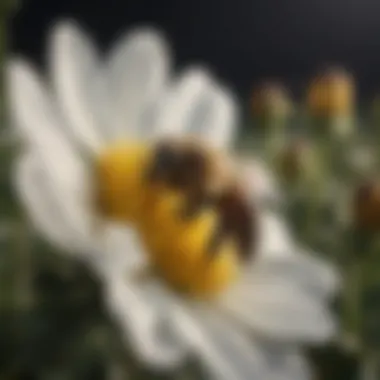
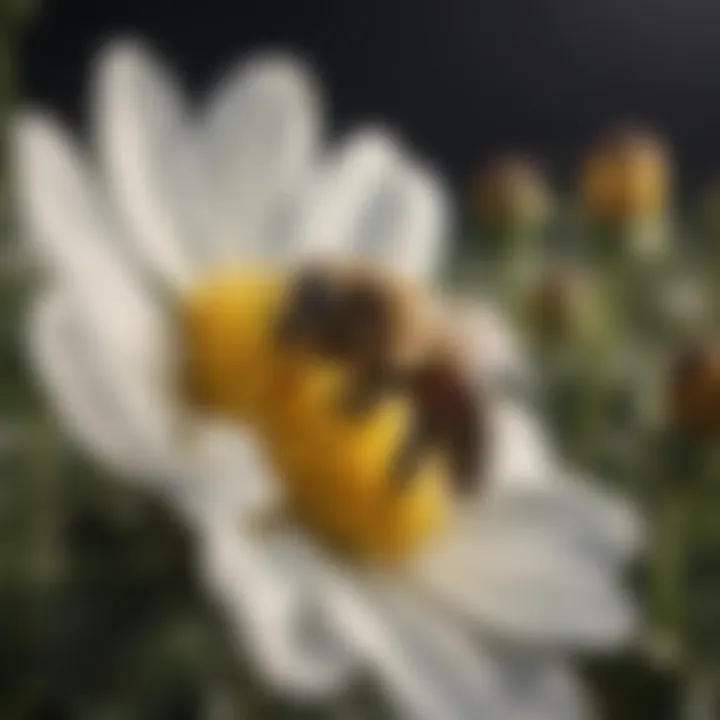
Climate Change Effects
Climate change represents a looming threat to bee populations, affecting their life cycles, behavior, and distribution. Changes in temperature and weather patterns disrupt flowering times, leading to a mismatch between when bees emerge and when flowers bloom.
- Shift in distribution: As climate zones shift, certain bee species may find it hard to adapt, leading to declines in their populations. For instance, species that are specialized for particular climates or floral resources may struggle more than generalists.
- Increased extreme weather: More frequent droughts, heavy rains, or extreme temperatures can degrade bee habitats and make it challenging for them to forage effectively.
Farmers can play a pivotal role by advocating for sustainable practices that mitigate climate impacts, such as crop rotation and preserving riparian zones.
Addressing these challenges isn’t just about saving bees; it’s about securing our agricultural future and maintaining the delicate balance within our ecosystems. Recognizing each of these threats provides a starting point for developing strategies to protect bees, ensuring that they continue to perform their vital role in our world.
Sustainable Practices for Bee Conservation
The conservation of bee populations has become increasingly urgent as threats to their survival ramp up. Sustainable practices play a pivotal role in safeguarding these valuable pollinators. By intertwining ecological principles with agricultural practices, we can not just preserve bee populations but also enhance the agricultural yield and biodiversity that relies on them. Being mindful about how we cultivate our land and interact with the environment can lead to healthier ecosystems and more robust farm outputs.
Creating Pollinator-Friendly Habitats
Establishing pollinator-friendly habitats is not just a nice-to-have; it is essential for the survival of bees. This can include anything from designing gardens that attract diverse floral species to preserving natural areas that provide shelter and food for bees. It’s about creating a smorgasbord for these industrious insects.
- Native Plants: Utilizing native flora is key since these plants are often better suited for local bee species. They usually thrive in local conditions and provide nectar and pollen that are integral for bee health.
- Pollen Diversity: A mix of flowering plants that bloom at different times throughout the growing season ensures that bees have access to food sources from spring through fall.
- Water Sources: Bees needs water too. Small ponds or simply a dish with pebbles or stones to land on can become inviting water stations without being major maintenance burdens.
"By incorporating even small patches of flowering plants into our environments, we can make a big impact on pollinator health."
In the end, a little effort in landscaping can foster a thriving habitat for bees, contributing significantly to their populations and, consequently, the health of agricultural systems.
Organic Farming Techniques
Adopting organic farming techniques is another step towards bee conservation. By avoiding synthetic pesticides and fertilizers, farmers create a healthier environment for bees and other beneficial insects. Organic farming is not only sustainable in its methods but also beneficial for the entire ecosystem.
- Soil Health: Organic practices improve soil quality, which in turn supports plant health and provides stronger, perhaps more resilient, flowers for bees to pollinate.
- Natural Pest Management: Instead of using harmful chemicals, organic farmers can rely on natural predators or biopesticides that do not disrupt the bee population.
- Crop Rotation: This can help maintain soil fertility and minimize pest outbreaks, reducing the need for external inputs that can be detrimental to pollinators.
These practices promote a balanced ecosystem where bees can thrive alongside crops. Thus, organic farming isn't just beneficial for human health but also creates a win-win for nature.
Community Involvement and Education
Perhaps the backbone of sustainable bee conservation strategies lies within community involvement and education. When local communities understand the importance of bees, they are more likely to take positive action. Education initiatives can range from school programs to local workshops, informing individuals about the crucial role of bees in pollination.
- Awareness Campaigns: Distributing literature on bee conservation or hosting talks can ignite interest and provoke action within communities.
- Bee Gardens: Community gardens that focus on bee-friendly plants can serve as hands-on experiences, letting residents see first-hand the benefits of supporting bee populations.
- Local Partnerships: Collaboration between farmers, schools, and environmental organizations can amplify efforts toward crafting comprehensive solutions that address bee conservation.
Involvement cultivates a sense of stewardship regarding the environment, fostering a collective effort that could have a lasting impact on bee conservation and overall biodiversity.
Future Trends in Pollination Research
Understanding future trends in pollination research is vital to safeguarding our ecosystems and agriculture. As we face growing challenges such as climate change and habitat loss, adapting our strategies to maintain and enhance bee populations becomes crucial. Research in this area not only informs agricultural practices but also seeks to develop sustainable methods. Highlighting emerging technologies and approaches helps provide insights for farmers and enthusiasts, who play a significant role in advocating for bee conservation.
Technological Innovations
In recent years, technological innovations have started to revolutionize how we approach pollination research. Robotics and drones are prominent in this space, serving as an excellent means to supplement traditional pollinators. For instance, some researchers have experimented with drone technology to pollinate flowers in areas where natural pollinators might have dwindled. This not only ensures crop yield but also opens a conversation about the potential for automation in agriculture.
Another area gaining traction is the use of sensors and data analytics. These technologies allow researchers to monitor bee behavior and flower access more accurately. Devices can track when and where bees pollinate, providing farmers with crucial data to optimize crop planting and enhance their yields. Such research contributes to understanding how bees interact with different flowers and can help develop better management practices.
"Innovation is not just a luxury—it's a necessity for agriculture in the face of environmental threats."
- Emerging applications of artificial intelligence in monitoring bee health follow closely behind. Researchers are now using AI tools to predict bee colony stress, which is essential in preventing loss and improving colony life cycles. By correlating bee health with environmental factors, studies have become increasingly sophisticated, thus paving the way for better decision-making in pollinator management.
Biodiversity Management Strategies
As we seek to ensure the longevity of bee populations, biodiversity management strategies are essential. Diverse ecosystems not only support a variety of pollinators but also create resilience against climate change and habitat destruction. Promoting polyculture farming, for instance, allows different species to thrive together. This is particularly advantageous for bees since they are attracted to diverse flowering plants, ensuring a rich diet throughout the foraging season.
Governments and organizations are gradually shifting focus towards enhancing biodiversity in agricultural landscapes. These strategies often include maintaining hedgerows, planting wildflowers, and setting aside land for natural habitats. Moreover, implementing policies that promote agroecological practices can lead to healthier soils and stronger ecosystems, creating environments where bees and other beneficial organisms can flourish.
Education and outreach also form a pivotal part of biodiversity management. Engaging local communities and farmers to adopt bee-friendly practices helps amplify the impact significantly. Workshops and training programs can provide vital information on maintaining natural habitats alongside crop production, ensuring that future generations of bees continue to play their critical role in pollination.
Culmination
In wrapping up our extensive exploration on the pivotal role of bees in flower pollination, it's vital to highlight a few key takeaways. Understanding the interaction between bees and flowering plants is not just an academic exercise; it's inherently tied to sustainability and agricultural efficacy. Bees serve as primary pollinators for many crops, contributing significantly to global food security. When we consider the importance of these relationships, the benefits are multifaceted: bees aid in maintaining biodiversity, support ecosystem resilience, and even enhance the nutritional content of food crops.
Summary of Key Points
Throughout this article, we've underscored several essential facets:
- Pollination Mechanics: We broke down how bees transfer pollen from one bloom to another, facilitating plant reproduction.
- Economic Impact: There's a clear economic benefit linked to bee pollination. It’s noted that crops like almonds, apples, and various berries rely heavily on these tiny but mighty creatures.
- Environmental Challenges: Issues like pesticide use, habitat destruction, and climate change are jeopardizing bee populations, which in turn threatens agricultural productivity.
- Conservation Efforts: We explored sustainable practices aimed at creating a friendlier environment for bees, such as organic farming and community education efforts.
In essence, the plight of bees signals a broader environmental crisis. Their decline serves as a barometer for the health of our ecosystems. If we do not mitigate these threats, we risk not only the loss of bees but also the stability of our food systems.
The Role of Bees in a Sustainable Future
Looking ahead, bees are central to sustainable agriculture. The intricate relationships between various species of bees and plants showcase a natural balance that, when disrupted, can lead to dire consequences. Supporting bee populations is more than a feel-good notion; it is a requisite for achieving food sovereignty and sustainability.
One practical step involves encouraging biodiversity. Farmers can plant a wide range of flowers to attract different pollinator species, ensuring that the bees have varied food sources throughout the growing season. Furthermore, adopting practices that minimize chemical use will create healthier habitats for bees and other beneficial insects.
In addition, public awareness campaigns can play a crucial role. Bringing communities together to understand the significance of bee populations can lead to grassroots movements for conservation. When people recognize the bees’ invaluable contribution to our food supply and ecosystem, they may be more inclined to support initiatives aimed at their preservation.
As we strive for a sustainable future, the lens through which we view agriculture must incorporate the health of pollinators. Bees are not simply an asset in the cultivation of crops; they are a cornerstone of ecological integrity. Their role in the pollination process is a reminder that nature's services are indispensable to human survival. By protecting them, we safeguard our agricultural practices and contribute to a resilient planet.



